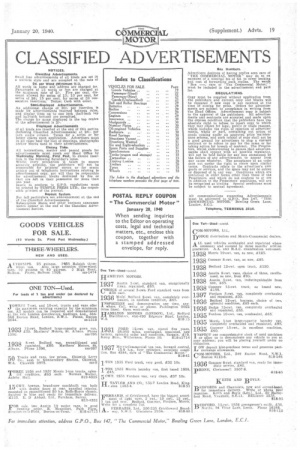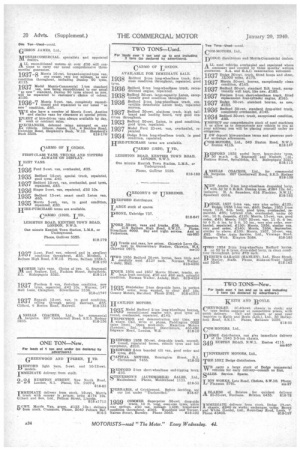THE BRUSSELS Si - low
Page 42

Page 43

Page 44

If you've noticed an error in this article please click here to report it so we can fix it.
AN "ERNATIONAL SHOP-WINDOW
NDUSTRIAL vehicles Once again form the largest
section of the Salon de Bruxelles, now in progress. The Show, which remains oPen. Until Sunday evening next (January 22), is bigger than ever this year, as a new annexe has been opened to house the motorcycle and cycle section, giving commercial vehicles -considerably more space. It is probably
the most international exhibition of its kind in the world, almost every motorvehicle-producing country being represented.
. Belgium is a. highly industrialized little country, and the market there is a good one; Whilst the world
publicity value of this Show is undoubtedly high. Many manufacturers regard it as a kind of international shop-window for the display of their products.
Taking all sections together, there are well over 1,500 exhibitors this year and excellent business is anticipated, for, althoughthere was a temporary setback during and after the national crisis, things are now well on the up-grade again.
It seems a pity that Great Britain does not have a larger representation at this Salon, which grows in importance each year. For the benefit of any manufacturer who may be considering the matter, it may he mentioned that heavy-duty chassis find the best market in Belgium, that is, 10-tonners and over, up to the Belgian legal limit of 22 tons.
Although there are, perhaps, fewer novelties than at last year's Salon, the Show presents much of interest, u32
and one outstanding feature is the continued improvement and progress in Belgian industrial coachwork, particularly where passenger vehicles are concerned.Always rather swamped by American and German exhibits, the national industry shows great vitality.,
Gas is well to the fore, both in the way of producer installations and in the use of compressed town-gas. Messrs. I3ovy-Pipe have developed an entirely new method of utilizing town-gas. Their system borrows much from the oil engine, and the power unit shown might almost oe termed a "gas-fuel semi-oiler." Instead of employing a mixing• valve, which usually replaces the carburetter when engines operate on compressed gas, the gas is injected with the aid of a Bosch fuel pump.
The pump simply operates hydraulic valves in the injectors, allowing gas to enter the cylinders, and the cycle of operations does not really follow that of an oil engine. Pure air is drawn
in, . during the induction stroke, and gas is injected at the commencement of the compression stroke. A normal compression ratio of 6 to 1 is employed, and the mixture is fired by plugs, whilst the injection pressure of the gas is' only 2 kg. per sq. cm. (28.4 lb. per sq. in.), as compared with an average of about 10 kg. in the case of an oiler.
The non-return valves of the Bosch pump have been removed, in order to allow the, oil to return, as it simply has a to-and-fro movement between pump and injectors. The greatest difficulty which cropped up in this design was to prevent gas
leaking past the injector valves. Any gas getting away like this is now recuperated by a special collector and "returned to store." Surplus oil from the hydraulic valves is also collected and returned to the pump.
Messrs. Bovy-Pipe claim to obtain 80 b.h.p. at 2,400 r.p.m. on town gas with the engine shown—a sixcylindered 5-litre unit of Lycorning origin, which is mounted in one of the firm's standard chassis.
Another Bovy-Pipe novelty is the Delvaux gazogene, for which the firm holds a manufacturing licence. In the Delvaux generator air is injected vertically downwards, through a nozzle located centrally over the furnace, and it is claimed that this obviates the necessity of putting nozzles into the hottest part of the fire and of watercooling them. A vacuum-operated control valve governs the quantity of air admitted, according to engine speed. Bussing vehicles have a great vogue in Belgium— especially the largest models—so much so that they are now being constructed in Brussels, and the first Belgian built chassis is on view. At present, these have imported engines, but from March 1 onwards engines will also be constructed in the Belgian works.
Two models new to Belgium are shown this year, a six-cylindered 105 h p. type and a relatively small fourcylindered oiler with a power unit developing 55 b.h.p. at 2,400 r.p.m. It is interesting to note that, in view of Belgian road conditions, the Belgian factory has modified the rear suspension and superimposed springs are now employed at the rear.
Turning again to gas-producers, a new one makes its appearance. This is the Bellay, an installation which employs a fuel mixture of anthracite and charcoal. Filtering appears to have been carefully studied in this appliance and, after passing through the usual cottonsheet filter, gas is given a final cleansing as it passes through layers of cotton wool. The generator has watercooled air-injection nozzles.
The trolleybus, completely neglected in France, seems to be making great strides in Belgium. After Antwerp and Liege, Brussels is now adopting this system, and Messrs. Brossel have just completed their first order for seven buses.
Two examples are shown, one a chassis and another a complete 50-passenger vehicle. Electrical equipment is by the Ateliers de Construction de Charleroi and the rest of the chassis by Brossel. These vehicles have centrally located motors and bevel-driven rear axles, whilst electric braking is on normal trolleybus lines.
The bodies, by Messrs. Paul D'Heutre, are excellent. They provide seating accommodation for 48 persons (with Dunlopillo cushioning) and room for 10 or 12 more standing passengers on the enclosed platform.
Apart from the trolleybus, Messrs. Brossel exhibit their latest oiler chassis for the Brussels municipal transport concern; it embodies several modifications. A separate gearbox is now employed, also a laterally mounted servo transmission brake of the Rolls-Royce type. Underslung worm drive is used, without doublereduction gearing. The power units have Ricardolicensed heads, but are, in all other respects, Belgian.
Quite an important industry has grown up in Belgium during recent years in the construction of industrial chassis having imported engines. Thus we find such concerns as Magistrae with a flourishing coach-production business, using the American Hercules, whilst S.D.S., another comparatively new concern, uses the British B34 Gardner. Both turn out fine vehicles and they represent only two examples out of quite a number.
The Miesse stand offers a curious spectacle this time, staging a complete range of models, right up to the famous eight-wheeled 22-tonner, familiar to English readers, which steers on three pairs of wheels and drives with the other two. Yes; but all these vehicles are displayed without any wheels and are just propped up on blocks of wood! The explanation is simple. Tyre manufacturers refused, just for once, to concede their customary 15 per cent. of show expenses !
As an example of what can be done in the Belgian market by importers, we might mention a conversation with the Belgian Volvo agent. (The Volvo is a Swedish vehicle mounting the Hesselmann oil engine.) " We made a start here two years ago," he said, "and during the first 12 months sold over two dozen chassis, which seemed to me a fair opening; but during last year we sold 250. As trade is developing, and with the Belgian heavy industries looking up, we hope to double this in 1939." Turning to the subject of coachwork, the Jonckheere concern merits a special word of praise. Apart from its own colossal stand, Jonckheere productions are to be found everywhere throughout this Show, and this success is well merited. Coaches, both large and small, are the concern's speciality.
An interesting exhibit is to be found on the F.N. stand. This is a mobile X-ray clinic, which is something of a masterpiece in the intelligent utilization of body space on a chassis of moderate dimensions.
A point which surprises one at the Brussels Show is the almost complete absence of municipal vehicles. There are two or three smart ambulances, one or two refuse-collectors, and that is all. Light delivery vans, also, are few, although those that do appear are good ones. In this connection, the little Renault van,
mounted on the " Juvaquatre " chassis, is of note. The M.A.N. concern shows a new oiler, or, at least, one new to Belgium. This is the Type L 5-tonner, and
it has an 8-litre six-cylindered oil engine.




















































































